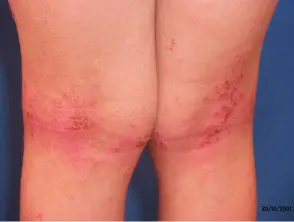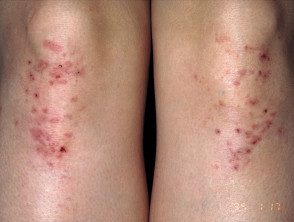What is a meal allergy?
Food allergy is a immune reaction to a dietary protein that is immediate (occurs seconds to minutes after eating or touching food) or delayed (occurs hours or days later). Allergic reactions It can occur when the affected person eats or touches a small amount of the responsible protein.
Food allergy is most common in young babies (4%), which often outgrow allergies. About 2% of adults also suffer from allergies to one or more foods. The tendency to food allergy runs in families.
Food allergy and skin
Skin conditions due to food allergy include:
- Some cases of anaphylaxis: severe reaction with urticarial eruption, shortness of breath and circulatory collapse.
- Some cases of acute urticaria- A hive reaction that occurs shortly after eating the responsible food.
- Some cases of contact urticaria: swelling and redness confined to the area that the food touches.
- Mucous membrane Contact urticaria: short-term irritation and swelling confined to mucosal surfaces, particularly the mouth and lips.
-
Oral allergy syndrome: Symptoms are triggered by eating specific raw foods in people with certain pollen allergies
- Tick bite induced red meat allergy
- Some cases of atopic eczema: exacerbations of eczema after eating certain foods.
- Some cases of allergic contact. dermatitis: Touching a food such as fig produces dermatitis in areas in contact with it.
- Some cases of photoallergic Contact dermatitis: touching a food causes dermatitis in areas in contact with it and then it is exposed to the sun.
- Protein Contact Dermatitis: Contact urticaria followed by dermatitis.
- Some aphthous ulcersfor example, due to allergy to chocolate or mint
-
Dermatitis herpetiformis (gluten) - A rare blistering skin rash associated with celiac disease.
Food allergy

Urticaria

Atopic eczema

Herpetiform dermatitis
Other symptoms of a food allergy.
Food allergy can cause the following symptoms.
Respiratory alergy
- Hay fever (rhinitis) - sneezing, running / itchy eyes
- Asthma - wheezing, shortness of breath, cough
Gastrointestinal allergy
- Nausea and vomiting
- Heartburn, reflux
- Colic, cramps, diarrhea, constipation.
- Irritable bowel syndrome (IBS)
Circulatory allergy
-
Anaphylaxis: low blood pressure, shock
What foods cause allergic reactions?
About 90% of systemic Allergic reactions are due to the following foods:
- Egg
- Milk
- Peanut
- Soy
- Fish
- Seafood
- Wheat
- Tree nuts
There are numerous other foods and plants that occasionally cause allergies. Some are listed here.
- Seeds and nuts such as cashew
- Fruits, including figs, kiwis, chestnuts, lemon, lime, and mango.
- Corn and maize
-
Garlic, leek and onion
- Vegetables, including artichokes, asparagus, celery, lettuce, parsnip
- Legumes (chickpeas, beans, peas, lentils)
- Herbs like mint, parsley, chives
- Spices such as Peruvian balsam and vanilla.
- Red meat (in tick bite induced red meat allergy)
An allergy can also be triggered by preservatives like parabens and flavoring agents or fragrances added to food.
How is a food allergy diagnosed?
A food allergy is diagnosed by taking a careful history of symptoms and their relationship to food, supported by examination results and test results. Unfortunately, neither the history nor the tests are completely reliable at all.
- A false positive means that the test was positive, but the patient is not allergic to the test substance.
- A false negative means that the test was negative, but the patient is allergic to the test substance.
The main food allergy tests are:
- Puncture tests
- IgE-specific blood tests (RAST)
- Patch tests, in some cases dermatitis
- Skin biopsy
- Antigliadin / antiendomysial blood test for gluten sensitivity / celiac disease and dermatitis herpetiformis.
Food intolerance
Not all reactions to food are allergic in origin. Intolerance can cause allergy-like symptoms, such as hives and dermatitis. But the reaction often depends on how much is consumed. These reactions are classified as follows.
- Allergy-like intolerance, that is, symptoms constantly arise from a specific food, but the tests are negative. Symptoms are often due to the FOD-MAP sugars in various foods.
- Phototoxic contact dermatitis to a plant such as lime or parsley.
- Irritants, as irritating hand dermatitis due to handling of vegetables and fruits; acid compound bite.
- Chemical intolerance, such as salicylate- and amine-induced urticaria.
- Food toxins, as erythema in scombroid fish poisoning.
- Enzyme deficiency, such as alcohol-induced porphyria cutaneous, alcohol redness.
- Excessive ingestion, as carotenamia by excessive intake of yellow or red foods.
-
Heavy metal toxicity of contaminants in food, such as mercury found in long-lived fish.
Food deficiencies
Skin conditions can also be due to dietary deficiencies, sometimes due to attempts to reduce exposure to the known or suspected Allergens.
- Protein / calorie malnutrition: kwashiorkor
- Vitamin B deficiency: pellagra
- Vitamin C deficiency: scurvy
-
vitamin D deficiency
- Zinc deficiency: acrodermatitis enteropathica
- Lack of iron
- Biotin deficiency
What is the treatment for a food allergy?
The basis of management is to identify which foods are responsible for the reactions and then avoid them. Prescribed treatments depend on the symptoms and may include:
-
Epinephrine injections for emergencies in case of anaphylaxis.
-
Antihistamines for urticaria and rhinitis.
- Current steroids for eczema
- Nasal sprays for rhinitis and inhalers for asthma
-
Dapsone for dermatitis herpetiformis
Food allergy prevention.
It is not known how to prevent all food allergies. Recommendations regarding the introduction of peanuts to baby food have recently changed.
- Children with mild to moderate eczema should have peanuts introduced around six months of age.
- Children with severe eczema, egg allergy, or both should be tested for peanut allergy, followed by introduction of peanuts at 4–6 months of age, based on these results.

